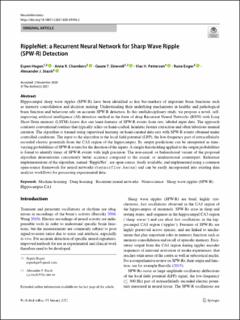RippleNet: a Recurrent Neural Network for Sharp Wave Ripple (SPW-R) Detection
Hagen, Espen; Chambers, Anna; Einevoll, Gaute; Pettersen, Klas Henning; Enger, Rune; Stasik, Alexander Johannes
Peer reviewed, Journal article
Published version
Permanent lenke
https://hdl.handle.net/11250/2837853Utgivelsesdato
2021Metadata
Vis full innførselSamlinger
Sammendrag
Hippocampal sharp wave ripples (SPW-R) have been identified as key bio-markers of important brain functions such as memory consolidation and decision making. Understanding their underlying mechanisms in healthy and pathological brain function and behaviour rely on accurate SPW-R detection. In this multidisciplinary study, we propose a novel, self-improving artificial intelligence (AI) detection method in the form of deep Recurrent Neural Networks (RNN) with Long Short-Term memory (LSTM) layers that can learn features of SPW-R events from raw, labeled input data. The approach contrasts conventional routines that typically relies on hand-crafted, heuristic feature extraction and often laborious manual curation. The algorithm is trained using supervised learning on hand-curated data sets with SPW-R events obtained under controlled conditions. The input to the algorithm is the local field potential (LFP), the low-frequency part of extracellularly recorded electric potentials from the CA1 region of the hippocampus. Its output predictions can be interpreted as time-varying probabilities of SPW-R events for the duration of the inputs. A simple thresholding applied to the output probabilities is found to identify times of SPW-R events with high precision. The non-causal, or bidirectional variant of the proposed algorithm demonstrates consistently better accuracy compared to the causal, or unidirectional counterpart. Reference implementations of the algorithm, named ‘RippleNet’, are open source, freely available, and implemented using a common open-source framework for neural networks (tensorflow.keras) and can be easily incorporated into existing data analysis workflows for processing experimental data.
